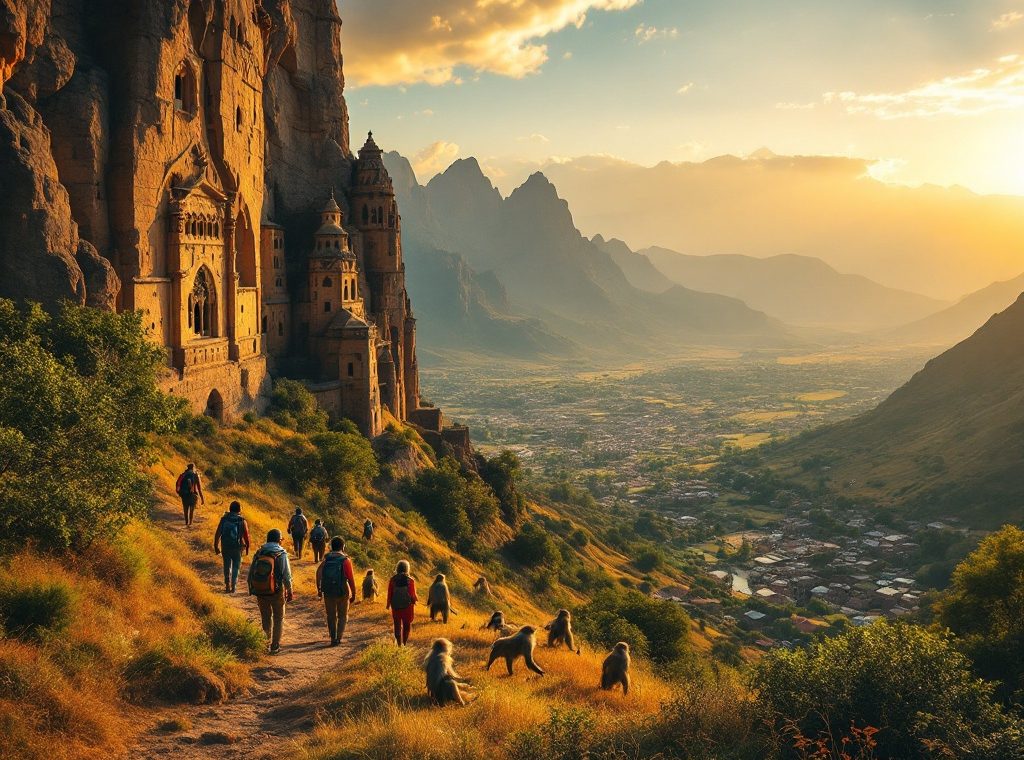Top Places to Visit in Ethiopia for First-Time Travelers
Dreaming of an exotic adventure? Discover Ethiopia, a land of ancient wonders and breathtaking landscapes. Explore the rock-hewn churches of Lalibela, trek through the stunning Simien Mountains, and witness unique wildlife like Gelada baboons. From vibrant markets in Addis Ababa to the otherworldly Danakil Depression, Ethiopia offers unforgettable experiences. Plan your journey now and uncover the magic of this captivating country!
Important information

- Ethiopia offers diverse attractions: historic sites like Lalibela’s rock-hewn churches (a UNESCO World Heritage site) and Aksum, natural wonders like the Simien Mountains and Danakil Depression, and vibrant cultural experiences in Addis Ababa and the Omo Valley.
- The best time to visit is during the dry season (October to March) for optimal weather.
- Visas are required for most nationalities, but an e-visa system simplifies the process. Check specific requirements and travel advisories before your trip.
- Accommodation ranges from budget-friendly to upscale, with options for cultural immersion like community guesthouses and eco-lodges.
- Ethiopian cuisine features injera (a spongy flatbread), flavorful stews (wats), and a rich coffee culture with traditional ceremonies.
Top Places to Visit in Ethiopia for First-Time Travelers
Ethiopia offers a wealth of experiences for first-time travelers. Explore the rock-hewn churches of Lalibela, a UNESCO World Heritage site. Hike amidst stunning scenery and rare wildlife in the Simien Mountains National Park. Discover the medieval castles of Gondar. Experience the vibrant markets of Addis Ababa. Witness the otherworldly landscapes and geological wonders of the Danakil Depression. Journey to Aksum to see ancient obelisks and ruins. The Bale Mountains National Park teems with diverse plant and animal life. Observe the unique hyena feeding rituals in the walled city of Harar. Immerse yourself in the rich indigenous cultures of the Omo Valley. For entry into Ethiopia, most nationalities require an eVisa. You can find more information and apply for your eVisa at eVisa Ethiopia.
Discover Ethiopia’s Wonders
- Explore the rock-hewn churches of Lalibela, a UNESCO World Heritage site.
- Hike in the Simien Mountains National Park amidst stunning scenery and rare wildlife.
- Discover the medieval castles of Gondar.
Experience Ethiopia’s Culture
- Experience the vibrant markets of Addis Ababa.
- Witness the otherworldly landscapes of the Danakil Depression.
- Journey to Aksum to see ancient obelisks and ruins.
Explore Ethiopia’s Wildlife
- Discover the Bale Mountains National Park, teeming with diverse plant and animal life.
- Observe the unique hyena feeding rituals in the walled city of Harar.
- Immerse yourself in the rich indigenous cultures of the Omo Valley.
Exploring Addis Ababa: Ethiopia’s Capital City
Discover Ethiopia, starting your journey in Addis Ababa, a dynamic capital perfect for first-time visitors. Explore the National Museum, home to the famous Lucy fossil. Delve into Ethiopia’s rich history at the Ethnological Museum. Experience the stunning architecture and royal tombs at Holy Trinity Cathedral.Immerse yourself in the vibrant atmosphere of Merkato, a large market offering an authentic taste of local life. Beyond historical landmarks and bustling markets, Addis Ababa is known for its thriving café culture. Savor traditional Ethiopian coffee ceremonies. Indulge in delicious local cuisine at the city’s numerous restaurants.
Top Cultural and Historical Sites
Explore Addis Ababa’s historical and cultural gems. Discover Ethiopia’s captivating past at the National Museum. Marvel at the stunning architecture of the Holy Trinity Cathedral, a renowned global attraction. Delve into the country’s history at St. George’s Cathedral. Reflect on a poignant chapter at the Red Terror Martyrs’ Memorial Museum. For a unique cultural immersion, visit the Ethnological Museum at Addis Ababa University.
Experiencing the National Museum of Ethiopian History
Explore Ethiopia’s rich history at the National Museum in Addis Ababa. This museum boasts a vast collection of artifacts, including the fossilized remains of “Lucy,” an ancient hominid ancestor. Discover fascinating insights into human evolution and Ethiopia’s captivating past.
Travel Planning for First-Time Visitors
Planning your Ethiopian adventure? Start by checking visa requirements, as many nationalities are eligible for an e-visa. Review any travel advisories specific to your country. Choosing the right time to visit is crucial due to Ethiopia’s diverse regional climates, especially if trekking is on your agenda, which is best during the dry season.
Begin your journey in Addis Ababa, the bustling capital. Explore its rich history and vibrant culture.
Witness the stunning rock-hewn churches of Lalibela.
For breathtaking landscapes, the Simien Mountains are a must-see destination.
These are just a few of Ethiopia’s many wonders. Start planning your trip today!
Best Time to Visit Ethiopia
The best time to visit Ethiopia is during the dry season, from October to March. The weather is pleasant with minimal rainfall, making it ideal for exploration. However, consider your specific destination and planned activities when choosing your travel dates. The Simien Mountains and Lalibela are especially stunning during these dry months.
Visa Requirements and e-Visa Process
Planning a trip to Ethiopia? Most travelers will need a visa, but the e-Visa system makes the process straightforward. Simply apply online and receive your visa electronically. However, specific requirements differ depending on your nationality, so review the latest regulations before your departure. Don’t forget to check out eVisa Ethiopia for more information.
Safety and Travel Advisories
Staying informed is crucial for a smooth trip to Ethiopia. Check your government’s travel advisories for essential updates on safety and potential risks, as conditions can change quickly. These advisories often highlight specific regions and offer valuable safety tips. By staying updated, you can ensure a safe and enjoyable Ethiopian adventure.
Accommodation and Budget Travel Tips
Ethiopia offers a variety of accommodations to suit every traveler’s budget and preference, from budget-friendly hostels to upscale hotels and eco-lodges. Whether you seek the vibrancy of city life or the tranquility of rural landscapes, Ethiopia has something to offer.
- Cities: Addis Ababa, Gondar, and Lalibela offer a range of hotels catering to different budgets.
- Cultural Immersion: For a truly immersive cultural experience, consider staying in rural community-run guesthouses or eco-lodges. This is a unique way to connect with local life and traditions.
Budget travel in Ethiopia is not only possible but also quite rewarding. Local transportation, food, and markets offer affordable options, allowing you to experience the country without breaking the bank.
- Transportation: Local buses and minibuses are readily available and inexpensive, making it easy to explore different regions.
- Food: Enjoy delicious and affordable meals from street food vendors and local restaurants.
- Shopping: Don’t forget to bargain in markets for souvenirs to bring a piece of Ethiopia back home.
- Travel Timing: Consider traveling during the shoulder seasons (spring or autumn) for lower prices on flights and accommodations. Each season offers its own distinct charm.
Where to Stay: Lodging Options
Ethiopia offers diverse lodging options, ranging from hotels in cities and tourist hubs to guesthouses for a more immersive cultural experience. For a unique stay, consider eco-lodges nestled within national parks like the breathtaking Simien Mountains.
Budget Travel Tips for Ethiopia
Traveling in Ethiopia offers budget-friendly adventures. Local markets overflow with unique and affordable souvenirs and goods. Public transport, such as buses, provides an economical way to explore the country.
Transportation and Getting Around
Traveling within Ethiopia offers several convenient options: long-distance buses connect cities across the country, local buses serve urban areas, and taxis are readily available, particularly in Addis Ababa. For quicker travel between major cities, domestic flights from Addis Ababa provide efficient access to various destinations.
Local Transportation Options
Ethiopia provides diverse public transportation, including buses, taxis, and matatus (shared minivans). These options offer flexible ways to travel throughout the country.
Cultural Experiences and Festivals
Experience Ethiopia’s vibrant culture through its unforgettable festivals.
Genna (Ethiopian Christmas)
Celebrate Genna on January 7th. Experience unique religious services that mark this special holiday.
Timkat
Witness Timkat, commemorating Jesus’ baptism, on January 19th (or the 20th in leap years). Enjoy colorful processions and reenactments of the baptism.
Meskel (Finding of the True Cross)
Experience Meskel on September 27th (or the 28th in leap years). The festival features the burning of the damera, a large symbolic cross.
Cultural Festivals: Genna, Timkat, and Meskel
Ethiopia offers a unique tapestry of religious festivals. Genna, Christmas, is celebrated on January 7th. Timkat, commemorating Jesus’s baptism, features vibrant processions and re-enactments. Meskel, observed with bonfires and parades, marks the discovery of the True Cross.
Unique Wildlife and Natural Wonders
Ethiopia’s Simien Mountains National Park, a UNESCO World Heritage site, boasts dramatic landscapes of rugged mountains and deep valleys. These areas shelter unique wildlife, such as gelada baboons and Walia ibex. Another natural wonder, the Blue Nile Falls (locally called Tis Abay), plunges spectacularly into the Blue Nile River, offering a breathtaking sight.
Gelada Baboons in the Simien Mountains
Gelada baboons are unique primates found exclusively in the Ethiopian Highlands, particularly in Simien Mountains National Park. Their fascinating social structures and distinctive heart-shaped chest patches make them a favorite sighting for park visitors, creating a truly memorable experience.
Blue Nile Falls and Other Natural Wonders
Ethiopia’s Blue Nile Falls, locally known as Tis Abay, or “Great Smoke,” are a breathtaking spectacle. The cascading water of the Blue Nile River creates a powerful display just 30 kilometers from Bahir Dar and near the falls’ source, Lake Tana. While not the tallest, their beauty and strength are captivating, evident in the magnificent gorge carved over time.
Simien Mountains National Park
A UNESCO World Heritage Site, the Simien Mountains National Park boasts dramatic cliffs, deep valleys, and unique wildlife like the Gelada baboon.
Danakil Depression
One of the hottest and lowest places on earth, the Danakil Depression presents an alien landscape of active volcanoes, vast salt flats, and vibrant mineral deposits.
Bale Mountains National Park
The Bale Mountains National Park showcases a variety of ecosystems, from Afro-alpine moorlands to lush forests, sheltering rare species such as the Ethiopian wolf.
Must-See Destinations in Ethiopia
Ethiopia offers a diverse range of travel experiences. Explore the rock-hewn churches of Lalibela, a UNESCO World Heritage site. Hike through the Simien Mountains National Park, encountering breathtaking views and unique wildlife. Discover the otherworldly landscapes of the volcanic Danakil Depression. Immerse yourself in the rich cultural tapestry of the Omo Valley, home to a fascinating array of diverse tribes. Seek adventure in the Bale Mountains National Park. Journey back in time within the ancient walled city of Harar. Each destination reveals a unique facet of Ethiopia’s remarkable beauty and rich history. Remember to secure your Ethiopian eVisa in advance for a hassle-free trip. Visit eVisa Ethiopia for more details.
- Lalibela: Explore the rock-hewn churches, a UNESCO World Heritage site.
- Simien Mountains National Park: Hike amidst breathtaking views and incredible wildlife.
- Danakil Depression: Discover a volcanic landscape unlike any other.
- Omo Valley: Experience the rich cultural tapestry of Ethiopia’s diverse tribes.
- Bale Mountains National Park: Find adventure in a haven for thrill-seekers.
- Harar: Journey back in time in this ancient walled city.
Lalibela: The Beating Heart of Ethiopia
Lalibela, a town nestled in the Ethiopian highlands, is renowned for its extraordinary rock-hewn churches. Eleven of these monolithic structures, carved directly from bedrock, showcase the remarkable ingenuity of 12th-century artisans. This UNESCO World Heritage site holds profound religious importance for Ethiopian Orthodox Christians, often referred to as the “New Jerusalem“.
Exploring the Simien Mountains National Park
Discover the breathtaking Simien Mountains National Park, a stunning landscape of peaks and valleys. Encounter unique animals like the Gelada baboons and the Walia ibex. Trekking routes cater to all skill levels, from beginners to seasoned hikers. This UNESCO World Heritage site showcases the natural beauty of the Simien Mountains, making it a must-see destination.
Visiting the Danakil Depression: A Volcanic Wilderness
The Danakil Depression, one of Earth’s hottest locales, presents a surreal landscape of active volcanoes, vast salt flats, and dazzling mineral deposits, attracting adventurous travelers. Beyond its geological wonders, this region is home to the Afar people and their rich cultural heritage, deeply intertwined with the challenging environment. Visitors can experience this unique culture firsthand.
Discovering the Omo Valley’s Tribal Communities
The Omo Valley in southwest Ethiopia is a vibrant hub of cultural diversity. The Mursi are famed for their lip plates, while the Hamer are known for their intricate hairstyles and the audacious bull-jumping ceremony. These are just two of the many tribes, including the Karo, Dassanech, Nyangatom, Arbore, Bana, and Bodi, that inhabit this valley. Each group contributes unique customs and traditions to this rich tapestry of human culture.
Adventure in Bale Mountains National Park
Explore the diverse ecosystems and vibrant jungles of Bale Mountains National Park. Observe incredible wildlife and unwind in comfortable cabins for an unforgettable experience.
The Ancient Walled City of Harar
Harar, a walled city in eastern Ethiopia, is renowned for its unique architecture and rich history. Its walls, constructed between the 13th and 16th centuries, enclose a captivating labyrinth of narrow, twisting alleyways and vibrantly painted houses. This ancient city, known as Harar Jugol, is a UNESCO World Heritage site, representing a distinct cultural tradition. It offers a fascinating glimpse into a unique heritage, setting it apart from other Ethiopian towns.
Must-See Historical Sites: Bahir Dar, Gonder, and Axum
Explore Ethiopia’s historical and natural wonders. Visit Bahir Dar, home to serene island monasteries on Lake Tana and the magnificent Blue Nile Falls. Discover Gondar, known for its unique history and Fasilides’ bath. Journey north to Debre Birhan Selassie church, a testament to Ethiopian artistry. Finally, uncover Axum’s ancient obelisks and ruins, offering a glimpse into Ethiopia’s rich past.
Sampling Ethiopian Cuisine and Drinks
Injera, a spongy sourdough flatbread, forms the foundation of Ethiopian cuisine, serving as both plate and utensil. With it, diners scoop up flavorful stews and vibrant vegetables, often seasoned with berbere, a distinctive spice blend. Lentils frequently accompany dishes like Doro Wat (chicken stew), Siga Wot (beef stew), and Shiro Wot, a chickpea or broad bean stew. A wide array of vegetarian options also exists, reflecting the Ethiopian Orthodox Christian fasting traditions.
Ethiopian Coffee
Ethiopian coffee ceremonies are integral to social life, providing opportunities for connection and community. During these ceremonies, green coffee beans are roasted, ground, and brewed in a jebena, a traditional clay pot.
Served in small cups, the coffee is often accompanied by popcorn or roasted barley, fostering conversation and storytelling. Considered the birthplace of coffee, Ethiopia boasts a diverse range of beans with unique flavor profiles, making it a haven for coffee enthusiasts.
Dishes
- Doro Wat: chicken stew.
- Siga Wot: beef stew.
- Shiro Wot: chickpea or broad bean stew.
Traditional Dishes: Injera and More
Injera, a spongy sourdough flatbread made from iron-rich teff, is a cornerstone of Ethiopian cuisine. Serving as both plate and utensil, it’s used to scoop up flavorful wats, a variety of stews. These range from the spicy chicken doro wat to vegetarian options like misir wot (red lentil stew) and gomen (collard greens). Sharing injera and wat is a deeply rooted cultural tradition in Ethiopia, transforming a simple meal into a communal experience.
Ethiopian Coffee: A Cultural Staple
In Ethiopia, coffee ceremonies are a cherished tradition, deeply embedded in the social fabric. Green coffee beans are roasted, then ground and brewed in a clay jebena, filling the air with a rich aroma. Served in small, handleless cups, this aromatic coffee is often accompanied by popcorn or roasted barley as a welcoming gesture. These ceremonies unite communities, forming an integral part of daily life, from casual get-togethers to festive celebrations.











